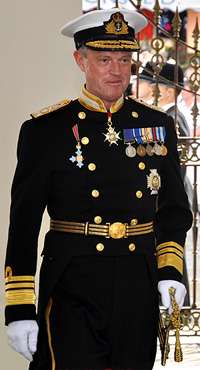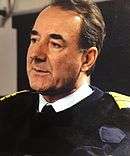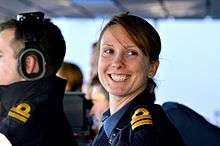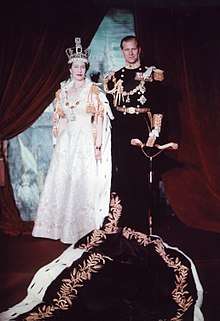Uniforms of the Royal Navy
The uniforms of the Royal Navy have evolved gradually since the first uniform regulations for officers were issued in 1748.[1] The predominant colours of Royal Navy uniforms are navy blue and white. Since reforms in 1997 male and female ratings have worn the same ceremonial uniform.[1]
.jpg)
 |
| Her Majesty's Naval Service of the British Armed Forces |
|---|
| Components |
|
|
| History and future |
|
|
| Ships |
| Personnel |
| Auxiliary services |
RN uniforms have served as the template for many maritime uniforms throughout the world, especially in the British Empire and Commonwealth. The uniforms of the Royal Naval Reserve, Royal Fleet Auxiliary, the Maritime Volunteer Service, the Sea Cadet Corps, the Navy branch of the Combined Cadet Force and the Volunteer Cadet Corps as well as modern uniforms of Trinity House, the Royal Australian Navy, the Royal New Zealand Navy and Royal Malaysian Navy are virtually identical to RN uniforms, with the exception of flashes at shoulder height and on rank slides. Royal Canadian Navy uniforms are also very similar, though the traditional sailor suit is no longer used and some distinctly Canadian rank insignia and titles are used; i.e., master seaman.
History
Officers
._by_Francis_Hayman.jpg)
Uniform regulations for officers were first issued by Lord Anson in 1748, and remained unchanged for nearly twenty years. Reportedly, the officers themselves advocated its adoption, as they "wished to be recognised as being in the service of the Crown."[2] The "best uniform", consisting of an embroidered blue coat with white facings, worn unbuttoned with white breeches and stockings, was worn for ceremonial occasions; the "working rig" was a simpler, less embroidered uniform for day-to-day use. In 1767 the best uniform was abolished and replaced by the working rig, with a simpler "undress" uniform for day-to-day use. By 1795, as a result of the French Revolutionary Wars, a plain blue "undress" coat had been introduced for everyday use, and epaulettes were officially introduced.[1] By 1846, all officers wore epaulettes. The white facings came and went over the years, briefly becoming scarlet (1830-1843). Though stripes of lace on the cuffs had been used to distinguish the different ranks of admiral since 1795, the first version of current rank insignia, consisting of stripes with a "curl" in the top one, was introduced for all officers in 1856.[3]
In 1825, the white breeches were replaced by trousers for officers serving in the United Kingdom, although the practice of wearing white trousers with naval uniforms (popularly known as “Wei-Wei Rig”) continued for officers serving overseas (e.g. in the West Indies and China) until 1939. Throughout the nineteenth century, there was great variation in uniform; officers paid for their own uniform, and often adapted it to fit civilian fashion of the time, as the Admiralty regulations governing uniform were not highly prescriptive.[1]
For service in tropical climates, a white tunic and trousers were introduced in 1877.[1] During World War II, a blue working dress on the lines of battledress was approved. Caps were to have white tops all year around, and blue caps were abolished in 1956.[3]
The distinctive white collar patch of the midshipman first appeared in 1758.[3]
Ratings
Uniform for ratings was first established by the Admiralty in 1857. Prior to this, most seamen wore "slops", or ready-made clothing sold to the ship's crew by a contractor; many captains established general standards of appearance for the seamen on their vessel, but there was little or no uniformity between ships. On one occasion in 1853, the commanding officer of HMS Harlequin paid for his boat crews to dress as harlequins, an incident which may have contributed to the Admiralty's decision to adopt a standard uniform.[1]
A number of changes have been introduced since the introduction of the first rating uniform, notably the removal of the blue jacket in 1890, and the replacement of bell-bottoms by flared trousers in 1977. In 1997 there was a major standardisation programme, meaning that all ratings now wear the same ceremonial uniform for the first time in history.[1]
Present-day uniforms
Present-day Royal Navy officers and ratings have several different uniforms; some are blue, others are white.
Officers
Ceremonial Day Dress

This is worn only by a few senior Officers (Admirals and Admirals of the Fleet, members of the Royal Family or Royal Household of Flag Rank, and the Vice-Admiral of the United Kingdom).[4] In addition, in the past several members of the Royal Family below flag rank; most notably Charles, Prince of Wales and Andrew, Duke of York wore this uniform whilst holding the ranks of commander and captain. It consists of a navy blue double-breasted tailcoat with standing collar faced white with gold edging, worn with gold shoulder boards, and gold laced blue trousers. Officers of the rank of Admiral of the Fleet, and also officers holding the appointments of First Sea Lord, Chief of the Defence Staff, Commander in Chief Fleet, Second Sea Lord or the Defence Services Secretary (if a naval officer) wear a full dress sword belt embroidered with oak leaves; others wear a full dress sword belt with three stripes. It is worn at parades such as Lord High Admiral's Divisions (BRNC) or at state occasions. Introduced in 1960, it is essentially the same Full Dress uniform worn for ceremonial occasions before that date only with the cocked hat replaced by the peaked hat and the epaulettes replaced by shoulder boards, and without the cuff slash and gold lace on the rear pockets. The ceremonial day coats worn by women button up the opposite way, and the tricorn hat is worn instead of the peaked cap (as worn by the Princess Royal).
No. 1 dress
.jpg)
This is the formal uniform worn on ceremonial occasions. For all commissioned officers it consists of a double-breasted, navy blue reefer jacket with four rows of two buttons; matching trousers; white shirt and black tie; peaked cap; and black leather shoes. It is divided into 1A (with medals and bearing arms), 1B (same as 1A, but without arms), and 1C (with medal ribbons). Female personnel may wear skirts except when carrying a sword or rifle. It was originally introduced in 1889 and was initially known as the 'undress coat'.[5]
No. 2 dress

This mess dress is worn in the evenings for dining. 2A is the formal evening dress for ceremonial dinners; it consists of a navy blue mess jacket with a white waistcoat (black cummerbund for female officers) with miniature medals. For officers of the rank of captain and above, a navy blue tailcoat (known as an 'undress tailcoat') may optionally be worn in lieu of the mess jacket. For officers of these ranks; in addition, gold-laced trousers (known informally as 'lightning conductors') may also be optionally worn either with the tailcoat or the mess jacket. 2B is "mess undress" for other mess functions, and is worn with either a black cummerbund or navy blue waistcoat and miniature medals. 2C, "red sea rig", is worn for informal evening wear on board ship; it consists of a white short sleeved shirt, worn with shoulderboards, without medals and with black trousers, black shoes and a black cummerbund.[5]
No. 3 dress


This is worn all year round for general duties. It consists of a white shirt with rank insignia on the shoulders, and appropriate headgear. For officers 3A dress includes a long-sleeved shirt and tie, while 3B includes a short-sleeved shirt but without the tie. 3C is the same in all respects as 3A but with the addition of a navy blue woollen jersey.[5] The beret may be worn with this dress only on certain occasions.
No. 4 dress

A new dark blue "modernised" combat uniform known as No 4 dress was introduced in 2012 on a trial basis for the crew of the new Type 45 destroyer HMS Daring, the Type 23 frigate HMS Westminster and Trafalgar-class submarine HMS Talent.[6] It is meant to be more versatile and adaptable to weather conditions, and has rank badges at the front rather than on the shoulders, collars that fasten with Velcro rather than buttons, and an optional baseball cap.
This was adopted navy-wide during 2015. It is divided into two categories: Number 4 RNPCS; which consists of a navy blue fire-retardant jacket (worn tucked in and with the sleeves rolled up), navy blue beret, navy blue stable belt, navy blue fire-retardant trousers, steaming boots, navy blue T-shirt and an optional navy blue microfleece, and Number 4R dress, which is the same only without the jacket and with an optional baseball cap, to be worn at sea. The peaked cap or sailor's cap may be worn with this dress on certain semi-ceremonial occasions.
This replaced No. 4 Action Working Dress (AWD), which consisted of blue shirt and trousers, both with flame retardant properties, worn with pullover (optional) and cap or beret. Specialist badges are worn on the sleeves; each branch and specialisation has its own insignia and are to be worn accordingly. Number 4AWD may still be worn by units that have not yet been issued Number 4 RNPCS. This is worn by all ranks and rates.[7][8]
No. 5 dress
No. 5 refers to the wide range of job-specific working kit worn by different personnel (e.g. medical, flight deck, boat crews, chefs, divers, etc.) for particular tasks. They are worn as required for duties.[5]
White uniforms
In the Tropics, officers wear on formal occasions a short sleeved white bush jacket with an open collar; matching trousers; peaked cap; and white leather shoes. Like temperate number 1 dress, it is divided into three categories: 1WA (with medals and bearing arms), 1WB (with medals but not bearing arms), and 1WC (with medal ribbons rather than medals and without bearing arms.)

Officers above the rank of commander, and those holding certain appointments, may optionally wear instead a long-sleeved, high-necked white tunic, with five buttons down the front, worn with white trousers and white shoes. Other officers may be instructed to wear this uniform so 'when required to conform with accepted international standards of dress on state or major ceremonial occasions'.[9]

There are also white versions of No. 2 and No. 3 dress which fulfil the same functions as their respective blue equivalents. Gold-laced navy blue trousers may be optionally worn with 2AW and 2BW dress by officers of the rank of captain and above. 3AW dress is the same as 3B dress, only worn with white shoes, white socks, and white trousers. White number 3B and 3C have been abolished. They consisted of a white short sleeve shirt and white shorts; 3B was worn with long white socks and white shoes, while 3C was worn with boat shoes. Both white 3B and white 3C dress have been replaced by the new number 4 RNPCS dress.[5]
Senior ratings
No. 1 dress

For senior rates petty officer and above, No. 1 Dress consists of a similar double-breasted jacket to commissioned officers except with only six buttons. Historically, this was originally known as the 'long jacket', and was first introduced for engine room artificers, masters-at-arms, and schoolmasters. Later, its use was extended to all Chief Petty Officers (1879) and Petty Officers (1920). Relevant rate insignia is worn on the left arm of the jacket by petty officers. Like their counterparts as worn by commissioned officers, it is divided into 1A, 1B and 1C dress.[5] In 1A dress, when armed, a white web belt and white gaiters are worn by senior ratings as they are by junior ratings.
No. 2 dress
This mess undress is optional wear in the evenings for dining by all senior rates. It is worn with a black cummerbund and miniature medals. The cut of the jacket is different from that worn by officers: it is double breasted, but features a shawl collar and only four buttons instead of six. Trade badges and other non-substanstive badges are not worn on the mess jacket, but cuff buttons and substantive rate badges are. This is worn with plain blue trousers and (optionally) the peaked cap. Those senior ratings who have not applied for mess dress for 2B dress may instead wear 1C dress with a black bow tie substituted for the black straight tie.[5]
No. 3 dress

This is the same as the various types of number 3 dress as worn by commissioned officers. Senior ratings wear shoulder rank slides with 3A, 3B and 3C but WO1s may optionally wear shoulderboards with 3A and 3C dress.[5]
No. 4 dress
Senior ratings currently wear the new number 4 RNPCS (Royal Navy Personal Combat System) dress.[5]
White uniforms
These are the same as the white uniforms currently worn by commissioned officers. The white tunic may be worn with 1AW dress and 1BW dress, but the white tunic worn by senior rates however differs from that of commissioned officers in that it only has four buttons rather than five and does not feature shoulder boards nor fittings for them. When armed, senior ratings wear white gaiters and white webbing belts, as with the blue version.[5]
Junior ratings
No. 1 dress
This is the formal uniform worn on ceremonial occasions. For junior ratings it is a traditional navy blue sailor suit. It is divided into 1A (with medals and bearing arms), 1B (same as 1A, but without arms), and 1C (with medal ribbons). Female personnel may wear skirts except when carrying a sword or rifle.[5] In 1A dress, when armed, a white web belt and white gaiters are worn.
The current uniform for junior ratings dates in its present form from 1906, replacing an earlier version introduced in 1856 that featured an untucked frock instead of the navy blue seaman's jumper, that was itself based on the traditional (but unregulated) dress of the seaman.
No. 2 dress
Mess dress is not worn by junior ratings but 1C dress is worn instead. 2C, "red sea rig", is worn for informal evening wear on board ship.[5]. However, the black cummerbund is not worn by junior ratings in this rig.
No. 3 dress
This is the same as for Officer's No. 3 dress but with the relevant rate insignia and seaman's cap (or beret). Junior rates are only issued with short-sleeve shirts and are not issued with ties. Thus No.3 dress is divided into 3B (without jersey) and 3C dress (navy blue jersey worn over the shirt with the shirt collar out). There is no equivalent of 3A dress for junior ratings.

No. 4 dress
Junior ratings, in common with all ranks and rates of the Royal Navy, are currently issued the new No. 4 RNPCS uniform. Similar to the British Army's PCS uniform, the rate/rank insignia has moved from the shoulders to the centre chest, sports a "mandarin collar" to enable anti-flash to be worn tucked in when the collar is up and replaces buttons with a hook and loop fastening, meaning a more comfortable fit when wearing body armour during boarding operations.[5]
No. 5 dress
No. 5 is the collective category for all specialist working uniforms. They are worn as required for duties. These include overalls, dry and wet suits, PTI uniform, dental and medical scrubs and combat uniform.
White uniforms
For junior ratings, the white No.1 is a white version of the traditional sailor's suit.
The white No. 2 and No. 3 are the same for the counterparts worn by officers and senior rates. However, only short-sleeved shirts are issued and worn and ties are not worn by junior ratings in these rigs.
Defunct uniforms
Full Dress

Introduced in its ultimate form in 1827, but had steadily evolved from the undress uniform introduced in 1748; this uniform was worn by all commissioned officers from sub-lieutenant upwards, as well as warrant officers. It consisted of a blue double-breasted tailcoat with eight gold buttons worn with blue trousers with gold lace down the side, bicorn hat, sword belt and sword with scabbard, and gold epaulettes (gold 'scales' were worn by sub-lieutenants and neither epaulettes nor scales were worn by warrant officers). It was placed 'in abeyance' (i.e. not used but not abolished) in January 1916 until the end of the First World War. It was restricted between the world wars to court levees. On all other ceremonial occasions, Frock Coat (with epaulettes) was prescribed. In July 1930, officers of the rank of commander and above were required to provide themselves with Full Dress.
It was again declared in abeyance with the outbreak of war in 1939, but was not formally abolished. Used on several ceremonial occasions after the war (such as the coronation of Elizabeth II), it was replaced in 1960 with the current Ceremonial Day Dress. A version of Royal Navy Full Dress, complete with epaulettes and cocked hat, is still worn by the Lord Warden of the Cinque Ports, but the current incumbent (Lord Boyce) wears his Royal Navy ceremonial day coat in lieu of this. It was last worn by Sir Robert Menzies during his tenure as Lord Warden from 1966 to 1978.
Round jacket
Colloquially known as 'the jacket', this was originally a more practical 'working' version of the full dress coat that was improvised by officers cutting off the tails of a spare undress coat. This practice was already informally widespread amongst officers at sea but in the 1825 regulations, the round jacket was finally given official sanction. It was only worn at sea, and was worn with either a peaked cap or a round (similar to a top) hat. It was abolished for all commissioned officers in 1891, but cadets and midshipmen still wore if for formal occasions until it was finally abolished for them in 1951.
Frock Coat Dress

This was introduced in 1847 and was divided into several categories: Frock Coat with epaulettes; which was worn with the bicorn hat and medals, Frock Coat without epaulettes, which was worn with the peaked cap. It became official 'working dress' in 1858. It was altered in 1933 by having only four buttons (instead of five) each side, three of which were to be buttoned. This enabled longer lapels to be incorporated, reflecting civilian fashions of the time. Frock Coat Dress was (like Full Dress) placed in abeyance and 'landed' in 1939, and although not formally abolished was not worn until it was finally abolished in 1949. A modified version of this uniform is still worn; usually with peaked cap and without epaulettes, by the Master and Elder Brethren of Trinity House.
Battledress
This was not introduced until comparatively late in World War Two, in contrast to its Army and RAF equivalents. From 1941, Army battledress was approved for use by Royal Navy personnel until 1943, when a Navy Blue version of battledress was introduced to be used only by the Royal Navy. Battledress stock from WW2 was still being worn at BRNC Dartmouth by Officers under Training (OUTs – now known as cadets or YOs – Young Officers) until the late 1980s. It was used as a formal ceremonial uniform until those officers received their bespoke tailored outfits towards the end of training.
See also
- British Armed Forces uniforms
- British Army uniform
- History of the Royal Navy
- Royal Air Force uniform
- Royal Navy officer rank insignia
- Royal Navy ratings rank insignia
- Uniforms of the Royal Marines
- The Royal Hospital School
| Wikimedia Commons has media related to Royal Navy uniforms. |
References
- National Archive page for naval uniforms
- Rank and Style, National Maritime Museum
- 'The Dress of Naval Officers', National Maritime Museum, 1966
- RN dress regulations 2014, annex 39b
- "Annex 39A RN Dress Tables" (PDF). October 2017. Retrieved 4 February 2019.
- "Royal Navy Puts New Uniform To The Test". Retrieved 21 February 2014.
- Whitehead, Tom (18 March 2012). "New Royal Navy uniforms to involve baseball caps and Velcro". The Daily Telegraph. London. Retrieved 2012-03-24.
- Malik, Shiv (18 March 2012). "Navy crew trial first new-look uniform in 20 years". The Guardian. London.
- "RN dress tables" (PDF). Royal Navy. February 2013.
Further reading
- Miller, Amy (2007) Dressed to Kill: British Naval Uniform, Masculinity and Contemporary Fashions, 1748–1857. National Maritime Museum, London. ISBN 978-0-948065-74-3.
- Chapter 38 – Policy and Appearance (PDF). Royal Navy Book of Reference 3. February 2013.
- BR 3 Annexe 39A - Royal Navy dress tables (with photos)
- BR 3 Annexe 39E - Naval Officers and Ratings: Illustrations of RN and QARNNS Badges of Rank, Rate and Other Insignia